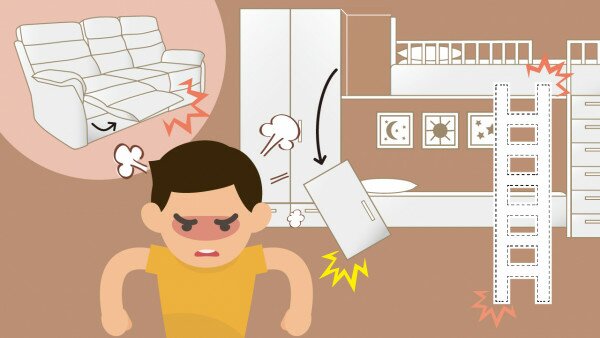Consumer disputes over furniture purchase are far from rare, despite all the time and money they are splurging on furnishing their home into one of blissful joy and comfort. Product quality and after-sales service are the main issues of complaints brought to the notice of the Consumer Council. These included: inferior or even unsafe furniture; unsatisfactory after-sales service of furniture companies failing to provide timely maintenance or adopting a delaying and indifferent attitude towards customer complaints. Also the furniture delivered was incomplete with some parts missing, or the merchandise clearly damaged.
The quality of home furnishings is a crucial part of home safety. The Council therefore calls upon furniture traders to strictly control the quality of their products, and to provide prompt and efficient after-sales service. Under the Sales of Goods Ordinance, sellers are held responsible to ensure the quality of goods is reasonably expected in terms of appearance, finish, safety, durability and suitability, etc. If they fail to do so, the consumers are entitled to goods return or refund.
When purchasing directly or placing order for custom made furniture, consumers should retain the purchase receipts or the order contracts clearly listing out the details agreed upon by both parties. Further, upon delivery of the furniture, carefully inspect the merchandise to verify the dimensions, materials and design, check out the accessories and ensure the construction is safe and sound. If any unacceptable scratch or damage is detected, take photos of the conditions and contact immediately the trader for follow-up.
Case One: Poor product quality and workmanship putting safety in jeopardy
The complainant placed an order with Company A for a set of custom made furniture – a bookcase/wardrobe cabinet/bed in a one-piece design – at a price of $10,600. Upon delivery, the consumer found defects at many places, and overall slipshod workmanship. A few days later, the slide door of the wardrobe cabinet atop the bed suddenly fell off. The complainant took photos and video of the conditions and notified the company. After one week waiting in vain, she went to the company in person whereupon she was told it was only an installation problem but she had to first return the fallen bookcase slide door before replacement would be arranged in 2 weeks.
As it involved safety concern, the complainant hired her own technician to check the safety of the whole furniture set. She also approached the Council but, despite repeated attempts, the Council was unable to contact the company concerned. The complainant was subsequently advised to seek redress through civil litigation.
Case Two: Unsatisfactory after-sales service resulting in non-maintenance
The complainant spent $7,382 purchasing from Company B an electric motor-operated leather 3-seater sofa. When the sofa was delivered she found a foot pedal control was malfunctioning – the left foot pedal would not retract to its original position. She called the company for maintenance but to no avail. Dissatisfied with the company’s attitude and product quality, she approached the Council for help in demand for an exchange of the defective sofa.
Upon the Council’s conciliation, Company B confirmed that the supplier had the malfunctioned foot pedal replaced and furthermore would offer a 5% discount coupon for future purchase.
Case Three: Furniture with missing part and defective construction
The complainant ordered a double bunk bed priced at $3,799. When delivered it was found that the ladder linking the upper bunk was missing, and a horizontal supporting bar with a deep fissure. The delivery man undertook to notify the company and left. After waiting for several days with no response he called the company’s customer hotline but no record of his complaint could be found. It transpired that the ladder in question was temporarily out of stock pending the arrival of new stock. A fortnight later the ladder did arrive but the issue of the cracked support bar remained unresolved. Worried about the safety of the double bunk bed, he approached the Council.
In response to the Council, the company promised to contact the complainant directly for arrangements to be made for onsite inspection and maintenance.
These complaint cases are typical illustrations of the problem areas consumers may encounter in the purchase of furniture, resulting in consumer inconvenience and concern. To ensure home furnishings to be purchased are suitable for use and safe, consumers should pay particular attention to the following:
Ordering for custom made furniture
- Remind the furniture company to do home and furniture measurements accurately, and ensure that the new furniture will not block socket outlets or doorway, etc. when being put in the intended position and space;
- Study the product sketch with care, and if you find anything disagreeable, inform the furniture company clearly for alterations;
- The order contract or receipt should clearly set out all the details agreed by both parties, including the materials to be used, colour, measurements, accessories, price and payment method, date of delivery, and warranty period, etc.
Purchasing ready-made furniture
- If buying display items of furniture, carefully inspect the merchandise prior to paying for signs of scratch, defective construction and substandard workmanship particularly at the joints. Retain the receipt and should any problem occur during the warranty period, take photos of the faulty areas and contact the trader without undue delay;
- Before purchase, also take into consideration if there is sufficient home space for the furniture and be sure the design of the furniture suits your own needs and requirements, for instance, if there will be enough storage space, etc.
Safety in Usage
- If there are children or elderly people at home, particular attention should be paid to the safety of the furniture, for instance, collapsible/foldable items should be equipped with safety locking devices etc. Take note also of the proper ways to use the furniture to prevent hazards.
The Consumer Council reserves all its right (including copyright) in respect of CHOICE magazine and Online CHOICE.



